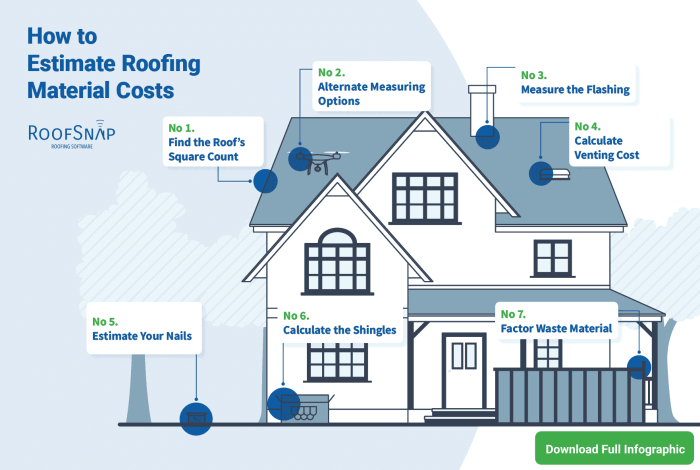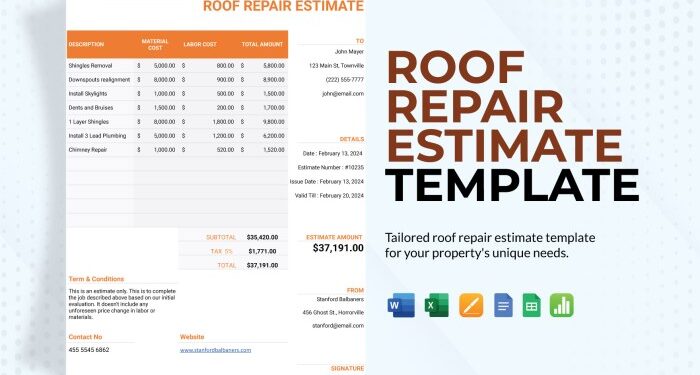Embark on a journey to uncover the secrets of accurately estimating roof repair costs, delving into the intricate details that shape the financial aspects of roofing projects.
Exploring the nuances of material, labor, and unforeseen expenses, this discussion aims to equip homeowners with the knowledge needed to navigate cost estimations effectively.
Factors Influencing Roof Repair Costs
When estimating roof repair costs, several factors come into play that can significantly impact the overall expense. Understanding these factors is crucial for accurate cost estimation.
Materials Used
The type and quality of materials needed for roof repair can greatly affect the total cost. High-quality materials such as premium shingles or metal roofing will naturally be more expensive than basic asphalt shingles. Additionally, specialty materials or custom-made components will also increase the overall cost.
Labor Costs
The cost of labor is another significant factor influencing roof repair costs. Skilled laborers with expertise in roofing will generally charge higher rates for their services. Additionally, factors such as accessibility to the roof, complexity of the repair, and time required for completion will all impact the labor costs.
Extent of Damage
The extent of damage to the roof is a crucial factor in determining repair costs. Minor repairs such as fixing a few loose shingles will be less expensive compared to major repairs like replacing a large section of the roof or addressing structural issues.
The more extensive the damage, the higher the repair costs will be.
Weather Conditions
Weather conditions can also impact roof repair costs. Repair work done during the rainy season or in extreme weather conditions may require additional precautions, equipment, or delays, all of which can increase costs. Planning repairs during favorable weather conditions can help reduce overall expenses.
Roof Accessibility
The accessibility of the roof plays a role in determining repair costs. A roof that is difficult to access or requires special equipment for repairs will incur higher costs compared to a roof that is easily reachable. Factors such as steep slopes, height, or obstacles obstructing access can all contribute to increased expenses.
Types of Roof Repairs and Associated Costs

When it comes to roof repairs, homeowners may encounter a variety of issues that need attention. Each type of repair comes with its own set of costs, depending on the extent of the damage and materials needed.
Patching a Leak
- Cost Range: $150 - $400
Patching a leak is a common roof repair that involves identifying the source of the leak and sealing it to prevent further water damage. The cost can vary depending on the size of the leak and the materials required to fix it.
Replacing Shingles
- Cost Range: $300 - $1,000
Replacing shingles is another common repair, especially after a storm or due to wear and tear over time. The cost can vary based on the type of shingles used and the area that needs to be replaced.
Fixing Flashing
- Cost Range: $200 - $600
Fixing flashing around chimneys, vents, or skylights is essential to prevent water from seeping into the roof. The cost depends on the extent of the damage and the type of flashing material needed.
Why Certain Repairs Are More Expensive Than Others
Certain roof repairs are more expensive than others due to various factors. For instance, repairs that require specialized materials or extensive labor will naturally cost more. Additionally, the accessibility of the repair area can also impact the overall cost. It's essential to consult with a professional roofer to accurately assess the repair needed and provide a detailed cost estimate.
Labor Costs and Estimation

Estimating labor costs accurately for roof repairs is crucial to ensure you stay within budget and receive quality workmanship. Labor costs typically make up a significant portion of the total repair expenses, so understanding how to estimate and negotiate these costs is essential.
Factors Affecting Labor Costs
- The complexity of the repair: More complicated repairs, such as replacing a large section of the roof or working on steep slopes, will require more time and skilled labor, resulting in higher costs.
- Accessibility of the roof: If the roof is difficult to access, contractors may need specialized equipment or additional safety measures, increasing labor costs.
- Materials used: Certain roofing materials may require more labor-intensive installation processes, impacting the overall labor costs.
- Season and weather conditions: Adverse weather conditions or working during peak seasons may affect labor costs due to increased demand or delays.
Negotiating Labor Prices with Contractors
- Get multiple quotes: Obtain estimates from several reputable contractors to compare labor costs and ensure you are getting a fair price.
- Ask for a breakdown: Request a detailed breakdown of labor costs, including hourly rates, number of workers, and estimated hours needed for the repair.
- Discuss payment terms: Clarify payment terms with the contractor to avoid any misunderstandings and negotiate a payment schedule that works for both parties.
- Consider experience and reputation: While cost is important, also consider the contractor's experience, reputation, and quality of work to ensure you are hiring a skilled professional.
Hidden Costs to Consider
When it comes to estimating roof repair costs, it's crucial to factor in hidden costs that homeowners often overlook. These unexpected expenses can significantly impact your budget and planning, so being prepared is key to avoiding any financial surprises during the repair process.
Unforeseen Expenses
- Structural Damage: Sometimes, during a roof repair, underlying structural issues are uncovered that need to be addressed. This can include damaged roof decking or support beams, adding to the overall cost of the repair.
- Mold or Water Damage: If water has been leaking into your home through the roof, there may be mold or water damage that needs to be remediated. This can be a costly addition to your repair project.
- Permit Costs: Obtaining permits for roof repairs is often necessary, and the associated fees can vary depending on your location. Make sure to include permit costs in your estimate.
Examples of Unexpected Costs
- Roof Deck Replacement: If the roof decking is found to be rotted or damaged during the repair process, it will need to be replaced, adding to the overall cost.
- Flashing Replacement: Damaged or improperly installed flashing around chimneys, vents, or skylights may need to be replaced, which can be an unexpected expense.
- Additional Materials: Sometimes, unforeseen circumstances may require additional materials or specialized equipment, such as a crane for large roofing projects, which can increase the cost of repairs.
DIY vs. Professional Repairs
When it comes to roof repairs, homeowners often face the decision of whether to tackle the project themselves or hire a professional. The choice between a DIY approach and professional repairs can significantly impact the overall cost and outcome of the repair job.
Cost Comparison
- DIY Roof Repairs:
- Costs associated with DIY roof repairs typically involve purchasing materials, tools, and equipment needed for the job.
- While labor costs may be minimal or non-existent, the quality of workmanship and potential for mistakes leading to additional expenses must be considered.
- DIY repairs are generally cheaper upfront but may end up costing more in the long run if mistakes are made that require professional intervention.
- Professional Roof Repairs:
- Hiring a professional roofing contractor involves labor costs, material costs, and possibly additional fees for permits or inspections.
- While the initial cost may be higher than a DIY approach, professional repairs often come with warranties and guarantees, ensuring quality workmanship.
- Professionals have the expertise and experience to identify underlying issues and provide long-lasting solutions, potentially saving money on future repairs.
Pros and Cons
- DIY Approach:
- Pros: Cost-effective in the short term, can be a fulfilling DIY project, flexibility in scheduling repairs.
- Cons: Lack of expertise, potential for mistakes leading to additional costs, safety risks, time-consuming.
- Professional Repairs:
- Pros: Quality workmanship, warranties/guarantees, expertise in identifying issues, time-saving, safety assurance.
- Cons: Higher upfront cost, reliance on external help, scheduling constraints.
Guidance on When to DIY or Hire Professionals
- Consider DIY if:
- The repair is minor and within your skill level.
- You have the necessary tools and equipment.
- You are willing to invest time and effort in research and execution.
- Seek Professional Help if:
- The repair is complex or extensive.
- You lack the expertise or tools required for the job.
- You want quality work and long-term solutions.
End of Discussion
In conclusion, mastering the art of estimating roof repair costs accurately can save you time, money, and headaches in the long run. By understanding the various factors at play and being prepared for hidden costs, you'll be better equipped to tackle any roofing project with confidence.
User Queries
How can I account for unforeseen expenses during roof repairs?
It's advisable to set aside a contingency fund of at least 10-15% of the total estimated repair costs to cover any unexpected expenses that may arise.
Is it possible to negotiate labor prices with contractors?
Yes, it's often possible to negotiate labor prices with contractors, especially if you have multiple quotes to compare. However, ensure that you're still getting quality workmanship at a fair price.
When is it best to opt for professional roof repairs instead of DIY?
Professional repairs are recommended for complex or extensive damage that requires specialized skills and equipment. Additionally, if safety is a concern or if the repair involves structural issues, it's best to hire a professional roofer.
















